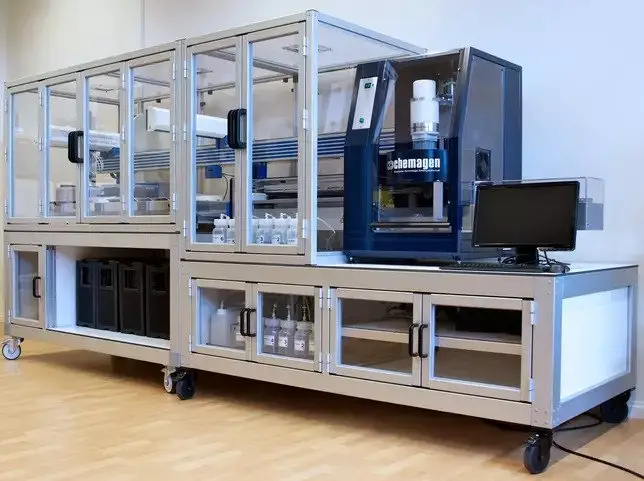A major Dutch blood bank approached us to play a role in the automation of their DNA extraction, normalization and PCR setup. The project was designed to form a centralized molecular platform within the organization. The platform is operated by several technicians from different departments. Therefor ease-of-use and flexibility plays a big role in daily operation. The organizations frontrunner role in quality standards required the project to have a validated sample tracking and tracing throughout the process. The process contains four major parts described below.
DNA extraction is performed on a Chemagic MSM I. DNA extraction is based upon magnetic bead techniques. The Chemagic MSM I is one of the few systems allowing samples to be used ranging from 200 μl up to 10 ml.The samples in this project origin from different sample materials such as, blood, tissue, cell culture and buccal swabs. The input volume from blood varies from 200 μl up to 3 ml. The system is adapted in a way that all these assays can be performed on the same system with minimum effort to change in between different sample types. If possible, different sample types can be combined to achieve a higher throughput on the platform. All sample preparations are done on an Xperimate liquid handler with an extended arm. The extended arm picks and places all reaction plates onto the Chemagic MSM I.
For all downstream assays, Normalization is required. The Normalization starts with a concentration measurement by a Trinean DropSense 96. The required sample volume is transferred by either the Xperimate or the Xiril liquid handler onto the DropPlate consumable. All data is transferred to the DropSense and quantification is performed. A worklist including the dilution volumes is created automatically and normalization is performed. The normalization factor is based upon the demands of the downstream application.
PCR setup is split into two major assays. The first assay is PCR mix preparation. The mix can either be prepared in exact amounts used during an assay, where volumes are calculated based upon the amount of samples, or it can be prepared in bulk for storage.
Any PCR mix can be prepared. To maintain flexibility, the specifications of the PCR mix are stored in the middleware software. When a new mix is added or the preparation of any mix changes, this is in full user control. Simply uploading the new settings will allow changes in mix preparation to be implemented easily.
PCR setup is a similar process. After starting the protocol, based on the worklist(s), the system will track and trace all samples, plates and reagents and performs the PCR setup. If different PCR conditions are included in the same run, the system will split them over several reaction plates.
All PCR mix and PCR setup reactions are performed on a Xiril Neon 150 liquid handler. The system is equipped with 8 channels and enough cooled decktrays to store all components. The integrated barcode reader scans all plates before starting the transfer. All data is collected throughout the run and stored in the workfiles for the LIMS system.
Quality plays a central role within the project. To achieve maximum quality and sample tracking and tracing, a custom made middleware software package is designed, including Graphical User Interface, called ProtoBase.
The ProtoBase Database contains all sample, reagents and consumables information. It also contains all assay information. Based upon the demands of the assay, ProtoBase stores all this information and allows the user to perform any assay and combine where possible. The data is communicated with the central LIMS software for long term storage.
The Graphical User Interface shows the user all options and sample lists ready for any assay in the process. Whether it is DNA extraction, normalization, PCR mix preparation or PCR setup, all settings and variables are shown. This allows the user to enter the process at any step ensuring maximum flexibility.
The user controlled access ensures that settings are not changed without the proper access level.
